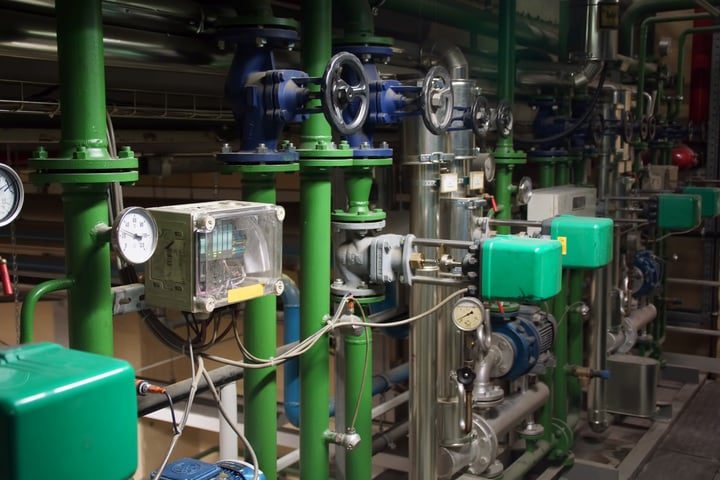Carbon Steel Tubing Inspection Methods

Carbon steel tubing is widely used across a diverse range of industries and needs to withstand extremely tough operating conditions in order to perform its important function. Failure can be costly and even catastrophic, so it is crucial that operations maintain a programme of regular, reliable inspection and monitoring to ensure optimal performance.
Steel tubing is used primarily in boilers and heat exchangers where it is subjected to significant environmental stresses including high heat, vibration, corrosion (from water, steam, chemicals and carbon dioxide), creep damage, pinhole leaks, baffle wear, mechanical damage, oxygen pitting and de-alloying (commonly found in brass condenser tubes). Extremes in temperature also put strain on the material as a result of the continuous expansion and contraction, which can result in thermal fatigue cracking.
There are numerous non destructive testing (NDT) techniques available for doing condition assessments of boilers, heat exchangers and their components but choosing the most appropriate one is crucial. Factors to consider include the type of components to be inspected, the type of defect that is most likely to occur in that application, accessibility of the tubing, the condition and cleanliness of the tubes as well as the individual needs of the operation.
Many equipment suppliers don’t look at the big picture, yet a holistic and flexible strategy that takes into account an operation’s entire NDT and inspection needs can result in substantial savings and improved efficiencies over time. Operations need to consider the amount of downtime that they can absorb and whether they can tolerate any level of invasion in terms of the inspection technique before making important technical equipment decisions.
When it comes to inspecting carbon steel tubing in boilers and heat exchangers, four main methods are used, namely:
- Saturation eddy current
- Internal Rotary Inspection System
- Magnetic Flux Leakage
- Remote field technologies
Each of these methods uses internal probes which travel the length of the tube to locate and identify potential problem areas and defects. Here’s a more in-depth look at each of them:
Saturation Eddy Current. Conventional eddy current probes aren’t appropriate for carbon steel tubing as they can’t penetrate the lining because of its high relative permeability. However, saturation eddy current can be used because the probe has a permanent magnet attached which reduces the tube’s relative magnetic permeability. There are plenty of innovative products in this category which have proven to be very successful in detecting pits, pin holes and wall loss in boilers and heat exchangers, and they can be used for both magnetic and non-magnetic materials.
Internal Rotary Inspection System (IRIS). This technology is widely acknowledged as the gold standard in terms of precision. It is used for inspecting virtually any type of metal or plastic tubing as well as steel tubing that is filled with water.
An IRIS probe is inserted into the tubing and works by sending out an ultrasound pulse from an ultrasonic transducer that is focused on a rotating 450 mirror. The mirror bends the ultrasound pulse by 900 and thickness readings are taken as it rotates and moves through the tube. Customised software interprets the readings (which are taken at a rate of up to 360 per rotation) to determine wall thickness and locate any weak spots as a result of metal loss caused by erosion and pitting. This technology can detect defects on both the inside and outside of the tubing wall.
Magnetic Flux Leakage (MFL). Magnetism is used to measure wall thickness and to detect leaks, cracks, areas of corrosion and pitting and although this is the fastest inspection method of the four, it isn’t necessarily the most accurate. Once magnetism has saturated the wall of the carbon steel tubing and magnetised the steel, hall-effect sensors or coils in the probes then detect any changes in the magnetic field. Software then converts these changes into amplitude changes and displays them in a graphic format. Accuracy may be affected as the technology can give very different amplitude responses for what are essentially the same defects, such as pits that are the same depth but which have different diameters.
Remote Field Technologies (RFT). This method uses the theory of electromagnetics to detect defects and is the fastest and most reliable inspection technique for carbon steel tubing. It can be combined with accessories such as crawlers etc which dramatically enhance inspection capabilities of hard-to-access areas such as the interiors of boilers etc.
Transmitter coils (called exciters) on the probes emit a low frequency electromagnetic field which travels along and through the walls of the carbon steel piping. The field is picked up by one or more receiver or detector coils and the data that is collected can reveal corrosion, erosion, wall thinning and baffle wear – all of which result in degradation of tube performance.
Should you need to inspect carbon steel tubing in your heat exchangers or boilers, Nexxis has the industry experience, knowledge and expertise to provide a practical, efficient and customised solution that meets your individual inspection and NDT needs. Contact us now.
